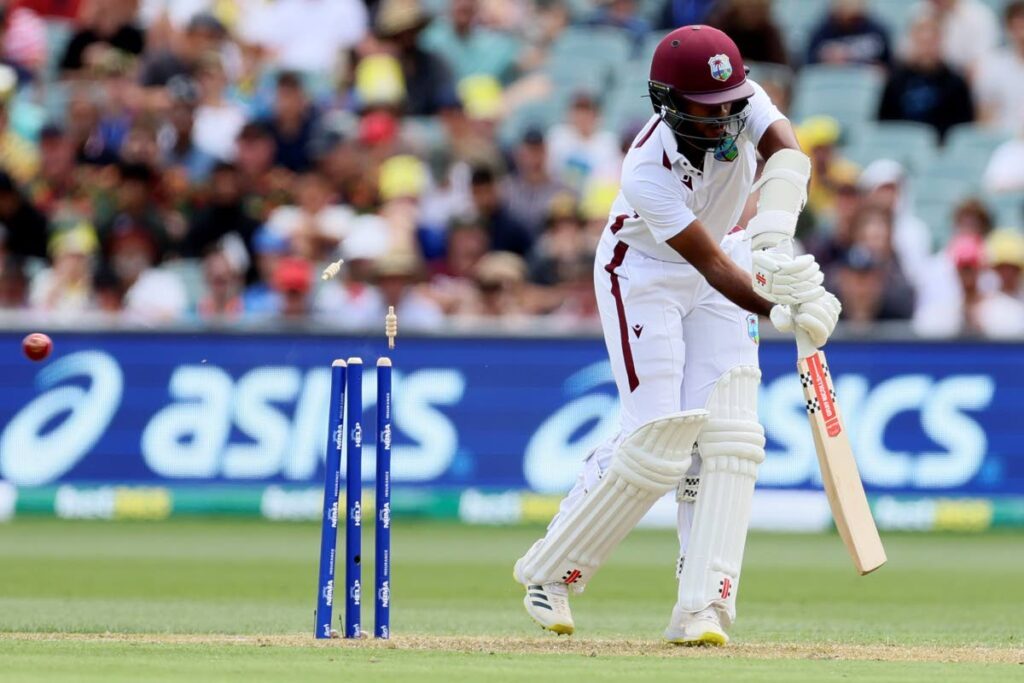Short answer: WI outplayed

Test cricket! The true test of the ability of a team is to bowl out the other twice, for fewer runs than one’s team has scored. It involves psychology of approach, the tactical acumen of the captain on the field, plus the trusted advice of senior players.
Cricket intelligence is absorbed from a cadre of coaches who pass on their experience to the captain to help him in his planning, although it is his responsibility to accept or deny the information.
However, the greatest challenge is the playing surface, which will determine the make-up of the team thought most advantageous in the hope of winning the game.
The pitch, popularly known as the wicket, is the main reason for improving one’s technique, in order to adjust. Will it be fast and bouncy, or slow and turning; will the bounce be variable or consistent?
Then the all-important question: whether it will last five days. It can deteriorate, and to deal with it, one needs special skills.
This is why Test cricket is a mentally testing sport. Games are lost through bad decisions made by the wrong reading of the conditions. This is why Test cricket is so different from limited-over matches.
For example, in a T20 game, before the game starts, a captain knows he is only allowed 20 overs. He also knows he is not allowed to bowl any bowler more than four overs, no matter how well he’s bowling. He’s told where he can and cannot place fielders.
The groundsmen are told to prepare flat pitches with even bounce.
This is to make it easy for batsmen to score runs quickly, including many boundaries, fours and sixes.
This type of cricket has its place; it’s especially for those who enjoy the slogging by batsmen, the constant chase of the ball by the fieldsmen and the many catches taken on the boundary – all exciting, heady and intoxicating stuff that is thrilling for a particular crowd.
Then there is Test cricket. Variable wickets. Drama and intrigue!
The West Indies are in Australia challenging the hosts in a two-Test series.
The first Test match started on January 17. It lasted two days and half a session of the third day of a proposed five-day game.

It was a low-scoring game because of the nature of the pitch, which was “bowler-friendly.” There was rain that week in Adelaide, which made preparation of the pitch problematic, especially for a Test match.
Enough water has to be in the wicket to make it last five days, and a generous amount of grass must be rolled in to ensure this happens. Nevertheless, with cool, rainy conditions and a constant cloud cover, the wicket did not have the necessary sunshine to be fully dried.
Hence, on winning the toss, Pat Cummins would have been very happy to ask the inexperienced WI team to bat first.
It soon became clear that the conditions would get the better of their guests. Tagenarine Chanderpaul has lost the proficiency he possessed a couple of years ago, and his skipper, Kraigg Brathwaite, also struggled.
The rest of the batsmen faltered after the shaky start of the openers. Only Kirk Mc Kenzie (50) took the fight to the seasoned bowling attack of the Aussies.
Although McKenzie’s innings was a worthy one, he eventually succumbed to the movement off the seam by Josh Hazlewood, who claimed four wickets for 44 runs off 15 overs.
Given the grassy, moist pitch, plus in-form, experienced bowlers, WI’s novices had little chance. At 133 for nine, WI’s Shamar Joseph, on debut, showed the stuff he’s made of, by striking with confidence to make 36. Not another batsman got to 20.
However, the Aussie batsmen suffered some stress as well. Seven of their first ten batsmen did not reach 20, and opener Usman Khawaja (45), was dropped at the wicket when on three. A brilliant 119 by Travis Head was assisted by the unimaginative tactics of Brathwaite, by not giving him the single and attacking the tailenders. The short-ball plan to Head was taken advantage of by the left-hander, who enjoyed it. That plan might work on faster wickets.
S Joseph (5/94) moved the ball both ways off the seam, and hopefully he will know how to adjust when the pitch is not assisting him.
Only McKenzie (26) and Justin Greaves (24) crossed 20 in the second innings.
WI are not up to standard at present.


Comments
"Short answer: WI outplayed"